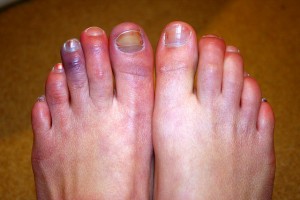What are Chilblains?
Chilblains(also called pernio) is a medical condition of the skin. The symptoms arise as small, itchy swellings on the skin that most commonly occur on the toes, fingers, nose and earlobes and can be very painful. They appear as patches of either a red, blue or white colour and can be turned into blisters if left untreated. Despite the discomfort from chilblains, it is important to receive treatment whilst suffering from the condition as it can result in an ulcer.
What are the symptoms?
- Small, itchy red areas on your skin, often on your feet or hands
- Possible blistering
- Swelling of your skin
- Burning sensation on your skin
- Changes in skin colour from red to dark blue, accompanied by pain
- Possible ulceration
What causes Chillbains?
The cause of Chilbains is due to a combination of cold weather and poor circulation. The tiny blood vessels under the skin constrict when the skin becomes old thus the blood supply to areas of the skin can be affected and start to slow. As the skin re-warms itself, the fluid from the blood vessels leaks into the tissues thus causing inflammation and swelling that turn to Chilbains. Tight shoes can also be a cause of Chilbains as they do not allow room for proper blood flow. The most particularly affected area are the toes.
Who is at risk of getting Chilbains?
Those at risk of getting Chilbains are teenagers, the elderly, and people with medical conditions such as anaemia as well as people who are overly sensitive to the weather. Furthermore, people with poor circulation and with other problems of their blood vessels are more prone to developing chilblains.
When is it most likely to occur?
Chilbains are most likely to occur in the cold weather and the speed (rate) of temperature changes. Some people get chilblains if they warm up cold skin too quickly or are otherwise susceptible to Chilbains due to other medical conditions. However, most chilblains occur in people who are otherwise healthy, which is why it is important to see your podiatrist.
How can we treat Chilblains?
Severe, ulcerating or recurring chilblains need professional attention. A qualified podiatrist can treat your chilblains and offer advice on prevention. If you suffer from severe and recurring chilblains, your doctor may prescribe a preventive drug. If you have a pre-existing condition, such as diabetes, you must see your doctor to check the circulation in the affected area without delay.
Preventing Chilblains
If you are susceptible to chilblains, you can reduce your risk of developing them by limiting your exposure to the cold, looking after your feet and taking steps to improve your circulation.
A few self-help measures can help, including:
- Wear warm clothes and ensuring your home is well heated
- Keep active
- Keeping regular visits with your podiatrist
- No smoking
- Avoid tight-fitting shoes and boots
If your skin gets cold, it’s important to warm it up gradually. Heating the skin too quickly, for example by placing your feet in hot water or near a heater, is one of the main causes of chilblains.
If you are suffering from chilblains, book in now by calling 8645 9800 or


